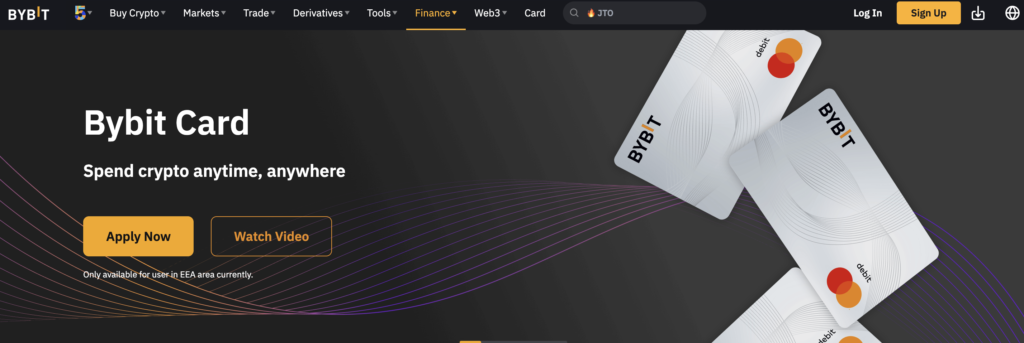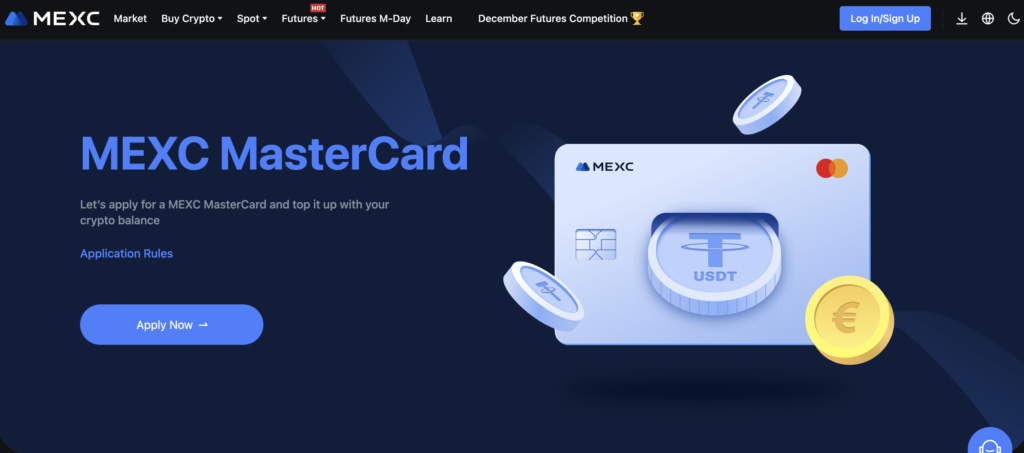In the dynamic world of digital finance, cryptocurrency cards, commonly known as crypto cards, are emerging as a pivotal bridge between traditional banking systems and the burgeoning realm of digital currencies. These innovative financial tools represent a significant leap in how we interact with and spend our digital assets. This article delves into the world of crypto cards, unraveling their mechanisms, benefits, and the transformative impact they have on both the cryptocurrency sector and everyday financial transactions.
In this text we will give you an overview of top 3 crypto debit cards, from ByBit, MEXC and Binance.
Key Benefits of Crypto Cards
To get a crypto card you have to sign up at a given crypto exchange, go through KYC process and then apply for a card.
- Ease of Use: Crypto cards provide a familiar and user-friendly interface, akin to conventional debit and credit cards, making them accessible even to those new to cryptocurrencies.
- Wider Acceptance for Cryptocurrencies: By enabling direct spending of digital currencies at merchants that accept traditional card payments, crypto cards significantly expand the utility of cryptocurrencies in everyday commerce.
- Instant Conversion: These cards automatically convert cryptocurrencies into fiat currencies, facilitating seamless transactions without the need for manual conversions.
- Rewards and Incentives: Many crypto cards offer attractive rewards programs, including cashback in cryptocurrency, which can be an additional source of income or investment.
- Enhanced Security: Crypto cards often come with advanced security features that safeguard users’ digital assets, providing a secure way to manage and spend cryptocurrencies.
- Global Functionality: With wide acceptance at a global scale, crypto cards empower users to transact internationally without the hassle of currency exchanges or high fees.
ByBit Crypto Card
The Bybit Card is a recent addition to the array of crypto cards available in the market. It’s a Mastercard debit card that allows users to spend their crypto funds easily and securely. Here are some key features and details about the Bybit Card:
- Card Types and Availability: The Bybit Card comes in both virtual and physical forms. It was launched in the first quarter of 2023 with the physical card being introduced in April. The card primarily caters to users in the EU/UK, with some exceptions.
- Features and Rewards: The card offers the convenience of spending your crypto assets locally or internationally at any location where Mastercard is accepted. However, it’s important to note that this is a debit card and not a credit card, meaning it doesn’t allow for borrowing against a credit line. Features like the Bybit Card VIP Program and Loyalty Rewards Shop were slated to be introduced in 2023.
- Integration with Mobile Payment Services: As of the information available, Apple Pay and Google Pay integration is expected to be live in 2024.
- Multi-Asset Spending: This feature, introduced in 2023, allows users to pay with any cryptocurrency available in their wallet. If the primary selected spending crypto (like USDT) is not available, the system will automatically convert other assets.
- Fees: The Bybit debit card has no annual fees, and there are also no fees for card cancellation or reissuance for the virtual card. However, users should be aware of the foreign exchange fee of 0.5% (on top of Mastercard’s rate) and a crypto liquidation fee of 0.9% (on top of spot fees).
- Eligibility and Application Process: To apply for the Bybit debit card, users need to have an active Bybit account with level 2 verification, including a linked email address and phone number, and enabled 2FA (Google Authenticator).
- Supported Currencies: The card supports fiat currencies like EUR and GBP and cryptocurrencies including BTC, ETH, XRP, USDT, and USDC.
In summary, the Bybit Card offers a convenient way for users to spend their crypto assets with the added benefits of a loyalty program and multi-asset spending. However, like any financial product, it’s important to consider the fees and restrictions that come with it. For more detailed information, you can visit the official Bybit website or their informational pages on the card.

Mexc Crypto Card
The MEXC MasterCard is a virtual card offered by MEXC, primarily aimed at users in select European jurisdictions.
Here’s a brief overview of its features and application process:
- Application Process: Users need to complete Advanced KYC and verify if their jurisdiction is supported for the card application. The application requires filling in personal information and submitting required documents. The verification process may take up to two business days.
- Usage and Top-up: Once approved, users can use the card by transferring assets to their MEXC Fiat Wallet and completing the deposit based on transaction needs.
- Fees: There is a 1% top-up fee. Within the EEA area, there is no transaction fee, while outside the EEA, the transaction fee is 2% (minimum €0.60 per transaction).
- Transaction Limits: The single transaction limit is 3,000 USDT, with a monthly transaction cap of 30,000 USDT and a card capacity of 100,000 USDT.
- Supported Jurisdictions: The card is available in a range of European countries including Austria, Belgium, France, Germany, Italy, Netherlands, Spain, Sweden, and Switzerland, among others.
- Eligibility: The service is available only to users who have completed KYC and purchased tokens before via bank card or bank transfer. It’s currently available only to selected inner test users.
The MEXC MasterCard offers a convenient way for users in supported regions to use their crypto assets for everyday transactions, combining the flexibility of digital currencies with the wide acceptance of MasterCard.

Binance Crypto Card
The Binance Card is a versatile financial tool for cryptocurrency users, particularly in the European Economic Area (EEA), although its services in the EEA will close on December 20, 2023. This Visa debit card allows users to spend cryptocurrencies for everyday purchases and withdraw cash, with the crypto being converted to fiat currency at the time of the transaction.
Key Features of the Binance Card:
- Virtual and Physical Card: The Binance Card is available in both virtual and physical formats.
- Supported Cryptocurrencies: It supports a variety of cryptocurrencies, including BNB, BUSD, USDT, BTC, SXP, ETH, EUR, ADA, DOT, XRP, AVAX, SHIB, LAZIO, PORTO, and SANTOS.
- Cashback Rewards: Users can earn up to 8% in BNB cashback for every eligible purchase made with the card. The percentage of cashback depends on the user’s card level, determined by the amount of BNB held in Binance wallets.
- Fees and Charges: There are no issuance or monthly fees for the card. However, a crypto conversion fee of up to 0.9% is applicable for withdrawals or purchases.
- Usage: The card can be used anywhere Visa is accepted, making it convenient for a wide range of transactions, including ATM withdrawals.
- Eligibility: Currently, the card is available to residents in specific European countries.
- Application Process: To get a Binance Card, users need to register a Binance account, complete identity verification, add a phone number from an eligible country, and then order the card through the Binance website.
- Top-Up Process: Users must transfer funds from their Binance Spot Wallet to their Funding Wallet to use the card. This transfer is free of charge.
- Withdrawal Limits: The card has specific daily spending and withdrawal limits, which vary based on the type of card (virtual or physical).
It’s important to note that the Binance Card‘s availability is subject to change, especially with the evolving landscape of digital currencies and regulatory environments. For users outside the EEA, or after the service closure in the EEA, other options might be worth exploring.

Crypto Debit Cards Summary
Here’s a comprehensive table with an overview of ByBit, MEXC and Binance debit cards.
Please use our VIP referral link to get the best deal.
| Feature/Aspect | ByBit Crypto Card | MEXC Crypto Card | Binance Crypto Card |
|---|---|---|---|
| Launch Date | Q1 2023 (Physical in April 2023) | Not specified | Not specified |
| Card Type | Mastercard (Virtual and Physical) | MasterCard (Virtual) | Visa (Virtual and Physical) |
| Primary Market | EU/UK (with exceptions) | Select European countries | European Economic Area (EEA) |
| Features | – Multi-Asset Spending; – Loyalty Program (Upcoming) | – Easy top-up; – Use via Fiat Wallet | – Up to 8% BNB Cashback; – Wide acceptance |
| Mobile Payment Integration | Apple Pay and Google Pay (2024) | Not specified | Not specified |
| Fees | – No annual fees; – Foreign exchange fee: 0.5%; – Crypto liquidation fee: 0.9% | – Top-up fee: 1%; – Transaction fee: 0% in EEA, 2% outside | – No issuance/monthly fees; – Crypto conversion fee: up to 0.9% |
| Eligibility | – Active Bybit account with level 2 verification | – Completed Advanced KYC; – Jurisdiction check | – Binance account with identity verification |
| Supported Currencies | EUR, GBP, BTC, ETH, XRP, USDT, USDC | USDT | BNB, BUSD, USDT, BTC, SXP, ETH, EUR, and more |
| Application Process | – Linked email and phone number; – Enabled 2FA | – Submit personal information and documents | – Register on Binance; – Complete identity verification |
| Transaction Limits | Not specified | – Single: 3,000 USDT; – Monthly: 30,000 USDT; – Card capacity: 100,000 USDT | Varies by card type |
| Special Notes | – Foreign exchange fee on top of Mastercard’s rate | – Available only to selected test users | – Services in EEA closing on Dec 20, 2023 |
This table provides a clear comparison of the key aspects of each crypto card, helping users make informed decisions based on their specific needs and preferences. Remember, the details are based on the information available as of now and are subject to change, especially considering the dynamic nature of the cryptocurrency market and regulatory environments. Always check the latest details from the official sources for the most accurate and up-to-date information.
Cryptocurrency Cards Future
As we stand at the crossroads of a financial revolution, crypto cards are not just a novel convenience but a symbol of the evolving relationship between digital and traditional finance. They are a testament to the growing acceptance and integration of cryptocurrencies into the mainstream economic system. While they offer numerous advantages, it is crucial for users to understand the associated risks and intricacies. In embracing these innovative financial tools, one can unlock the potential of digital currencies, making them a practical and integral part of everyday financial activities.
As the crypto landscape continues to evolve, crypto cards are undoubtedly paving the way for a more inclusive and versatile financial future. They provide a bridge between cryptocurrency world and traditional market.
Learn more about Top Crypto for 2024 here.
P.S. the above links are affiliate.


Leave a Reply